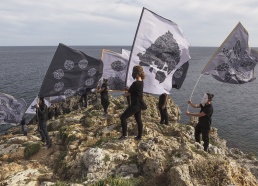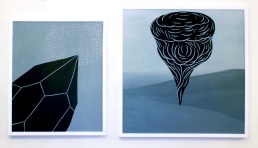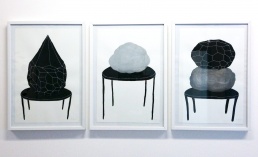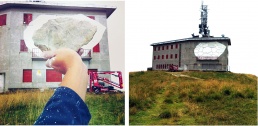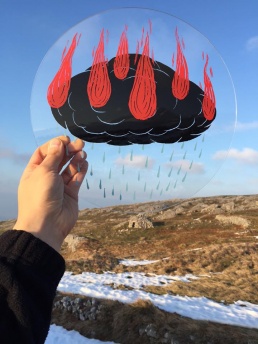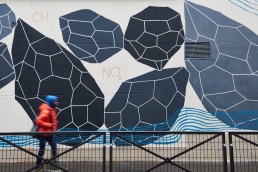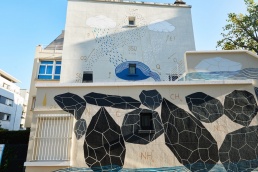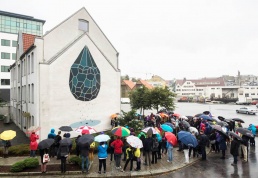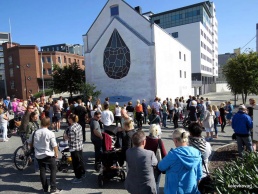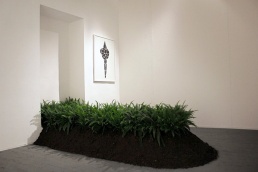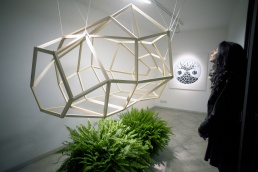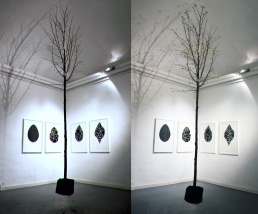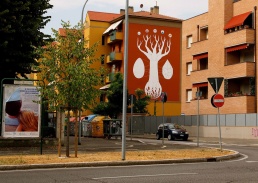This is Andreco
Interview by Crist Espiritu.
Art by Andreco.
Feature Photo by Mark Shaw.
“I found it more interesting to draw the feeling behind the bodies than the naked body itself, going deep, under the surface of the skin. So I started to draw people with internal organs exposed.”
Let us start with a bit of your history. When did you start doing art? Would you say that you’ve always known that you’re going to be an artist?
Since I was a child I was attracted to the arts, but only when I went to college at the age of 19 that I started drawing more seriously everyday. At that time I was studying math and physics and at the same time I was filling the edge of scientific books with my sketches. Drawings were a way to liberate the irrational part of my thought and an escape from rationality. Creating artworks was a way to discover and let out my deeper emotions, I felt satisfied in making something that I was searching for but was unable to find.
What were your subjects? What were the things that fascinated you back then?
I started drawing in an older painter’s studio in Rome where he organized live painting sessions with models. I found it more interesting to draw the feeling behind the bodies than the naked body itself, going deep, under the surface of the skin. So I started to draw people with internal organs exposed. At the beginning it was a provocation against the aesthetic and conventional sense of beauty, after some time it became a statement. I was interested in alchemy and symbolism; the internal organs became my personal set of symbols. After that period my interest moved from the humans to the environment around them and I started to find a new set of symbols that “resume” Nature and the relations between human and Nature. I focus on stones, mineral, clouds and natural elements.
Did you go to art school?
No. I love to study in an art school though. I have a Post Doc in environmental and civil engineering. I studied by myself. In the academy of arts some time I’m called for give seminars about public art and every time that I have to start with a new class I use to say: “I’m sorry I’m an Engineer. I never studied in an art school, you are very lucky to be here, today I don’t claim to teach you nothing, I will just talk about some personal experience about public art I had recently.”
“Behind my artworks there is a long multidisciplinary research.”
What would you say were the most important things you learned academically?
In the University I learned to study, a methodology that is useful to feed my curiosity. Behind my artworks there is a long multidisciplinary research.
How did you get started painting in the streets/ doing public murals?
I was very young when I pasted my first drawing in the street, if I remember well it was for an anti-war demonstration at the end of the nineties. Doing an anonymous intervention on the wall was a way to break with the boring part of reality. I never did graffiti writing, my background was more related to situationism, poetry and political direct actions. In 2001, with some friends we had our first collective drawing show, in a beautiful ancient building in Rome. For that show we decided to paste some drawings in the streets too for at least two reasons: to give all the people of the neighborhood the possibility to see them and, of course, to make some “noise” in town, since these practices were unprecedented in Rome. It was my first show and my first street intervention as Andreco. Since that time I started making posters with a more artistic purpose. I pasted posters systematically until 2006, after that I started using more paint and less paper and glue, it was the beginning of doing murals.
What would you say is your most favorite aspect of doing public art?
In time my public art projects became more organized and planned. I like to think a project that takes into account the people, the architectures, the nature, the history and the identity of the locations where I’m going to create the piece. I love to work site specific and when is possible, I try to involve the local community.
“I like to think a project that takes into account the people, the architectures, the nature, the history and the identity of the locations where I’m going to create the piece.”
Tell us a little bit about your current style? How did you get into abstraction? Who were your influences?
In the last few years my art research was inspired from my scientific studies about environmental sustainability. The environmental issues became one of the main subjects of my artwork. In particular, the Climate change consequences, the physics reactions and transformations due to human pollution, the anthropocene theories and the transition to a renewable society. Also a strong influence is given by the natural shapes.
“In public art the artist must put away his EGO and do something that is in relation with the location and the people of the neighborhood.”
My drawings are not figurative and even not abstract, they are something in between. They are shapes that hide an “open meaning”. The meanings became certain in the mind of the observer after his personal interpretation. When I’m producing a new shape I try to be balanced and deep as I’m creating a sacred icon. I like to realize my minimal shapes, as reduction of the pure theoretical concepts that inspire me.
Among science and nature I get inspired by philosophy and poetry, contemporary dance and theatre, architecture and of course visual arts. If you are asking me some names, It’s hard to do a short list of the artist that I like, I’ll try: Joseph Beuys, Richard Long, Richard Serra, Gordon Matta Clark, Sol Lewit, Maya Deren, the italian Arte Povera movement especially Penone, the Situationist International movement and Fluxus, just for mention some big reference.
What do you look for on spaces where you decide to do public art?
Architecture, Environment, stories about the place and the people that live there.
Do you have a favorite piece? If so, what is it and what is it all about? Also , why is it your favorite?
One of my favorite peace is Nomadic Landscape when I decided to hang in a gallery the tree that, according to the national research center, is the best in absorbing CO2: during the show it began to blossom, the best unplanned performance I could ask for, it was a success and I didn’t have any merit for it.
What do you think is public art/street art’s role in today’s society?
Art has a role to break with the monotony of reality and push the boundaries of the imaginary stimulating perception and creating new points of view. Public art has the stronger responsibility of doing it in front of the eyes of everybody, not only the art world. In public art the artist must put away his EGO and do something that is in relation with the location and the people of the neighborhood.
“I’m sorry guys I’m an engineer I feel I can’t give you any advice in Art. I only suggest to be yourself and do what you like with extreme passion, one day what you like could become your job.”
A lot of upcoming artists are reading our articles. Do you have any advice for them about getting in the art game?
I’m sorry guys I’m an engineer I feel I can’t give you any advice in Art. I only suggest to be yourself and do what you like with extreme passion, one day what you like could become your job.
Follow Andreco on Twitter and Instagram @andreco_
Follow Crist Espiritu on Twitter and Instagram @crist_espiritu
